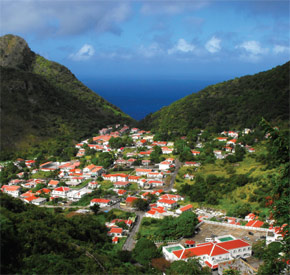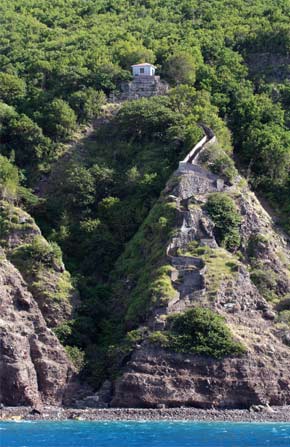
One of the most overused clichés in our modern world is “sometimes it’s better to be lucky than it is to be good.” Regardless of your position on this saying, there is some truth to it. Recently on our trip to St. Maarten in the Netherland Antilles, I enjoyed a wonderful day made even more so by “luck.” It all started with a fairly major screw-up. I thought we had a superb plan, but it quickly turned sour. Let me tell you about it.
We were spending two relaxing weeks in St. Maarten at a charming guest house called “The Horny Toad.” (Please, no comments here.) The island is half Dutch and half French and is the largest of a collection of islands which include such notables as St. Barthelemy, Anguilla, Saba, and others. One of the pleasant diversions is visiting these neighbors by high-speed ferry. Each has its own individual character and charm. My story takes place on the island of Saba – our favorite.

Let me first get the boring details out of the way. While its neighbors are mostly flat with fine sandy beaches, Saba is more vertical than horizontal – rising to a height of almost three thousand feet from an off-shore depth of more than three thousand feet. There are no beaches – only jagged volcanic rocks. The total population is only eighteen hundred people, and making a living here is very difficult.
For those of you who are detail-oriented travel buffs, you may have read the fascinating tale of Saba and its roads. Briefly, before the 1930s it had none – due to the rugged, treacherous terrain. The official wisdom was that it was impossible to build any roads on this little speck of volcanic protuberance. Being frustrated by this thinking, a native of Saba – Josephus Lambert Hassell – took up this challenge. He studied civil engineering by correspondence courses and convinced a crew of locals to start building a road in 1939. By 1958 the entire thoroughfare to the airport had been completed. It is called simply “The Road.” There are two to four hundred foot drop-offs on one side or the other. Driving is not for the faint-of-heart.

Our plan was to hop the early morning ferry, take a cab up to the fairly level section at the top of the road called Windwardside, and slowly make our way down by paths and walkways we assumed would be there.
Now days of the week lose significance while lolling on beaches, and we inadvertently selected a Sunday for our adventure. Bad move. We climbed off our ferry, along with six or eight others, and scrambled up to the narrow flat ground, avoiding the signs which warned “Stay clear, falling rocks.”
Alas, our first major obstacle – no taxis. We stood there, two wayward waifs, wondering what to do next. Now it so happened that a yellow van with School Bus prominently displayed on its side arrived and disgorged about ten kids who were being loaded on to the ferry for a brief holiday on St. Eustatius, another adjacent island.

As the yellow school bus pulled out, the driver, a native of Saba saw us standing there and asked if he could be of any assistance to us. We described our dilemma and his reply was, “Hey, no problem. Get in the bus and I will give you a tour.” How could you refuse such a grand offer?
Our new-found friend’s name was Cyril. He was born in Saba and lived on the island most of his fifty some years. He claimed to know everyone on the island and went on to prove it as he greeted all the walkers and the knots of folks who were standing in shaded areas, enjoying the warm eighty degree weather and the cooling ocean breezes. Every car that passed was hailed with a friendly wave and a short honk of his horn.
He showed us the tiny airfield carved out of rock at water level and proudly told us it is the shortest commercial, sanctioned runway in the world. It certainly was shorter than most modern US aircraft carriers. He took us to the monument which had been erected in honor of the civil engineer who took on the impossible task of building these complex roads. Along the way he showed us pictures of his grandfather who had been working on them.
Best of all we stopped at his house and met his four-month-old dog – that is puppy – who greeted him with unreserved joy. Declining to join us for lunch, he dropped us off at a little restaurant overlooking a steep valley and told them to seat us on the patio. The food was delicious, the view, which fell off over one thousand feet, was breathtaking, and the birds and flowers surrounding our perch were delicate and colorful.
He pulled up just in time to take us down to our ferry to return to St. Maarten. If you ever get down into that area I strongly recommend visiting this little Dutch island, especially if you are a diver. The place is a pleasant oasis, but best of all the people are open, generous, and very, very friendly.
I’m glad we screwed up, chose a Sunday, found no taxis, and made other mistakes. They turned our adventure into one of the luckiest days of our trip. We met a fine citizen of Saba, and maybe best of all it gave me a story to tell.
Harry Hubinger is a retired engineer who operated his own company for twenty years. He first began traveling outside the United States on business, but these visits escalated upon his retirement. He has now traveled to 115 countries and continues to add several new ones each year. In 1998 he began writing his humorous and insightful articles for a supplement to a local newspaper. These stories, based on experiences most travelers could identify with, soon earned him a wide local following. In 2005 he published his first book, Stamps in My Passport—a collection of travel vignettes. Harry has lived in Danville for almost forty years and has volunteered with the Danville Police Department for the past seven. His wife, Barbara, is the detail chronicler of their trips. Her journals provide the background for Harry’s broader view. You can get his book at: www.travelbookspub.com.
Leave a Reply